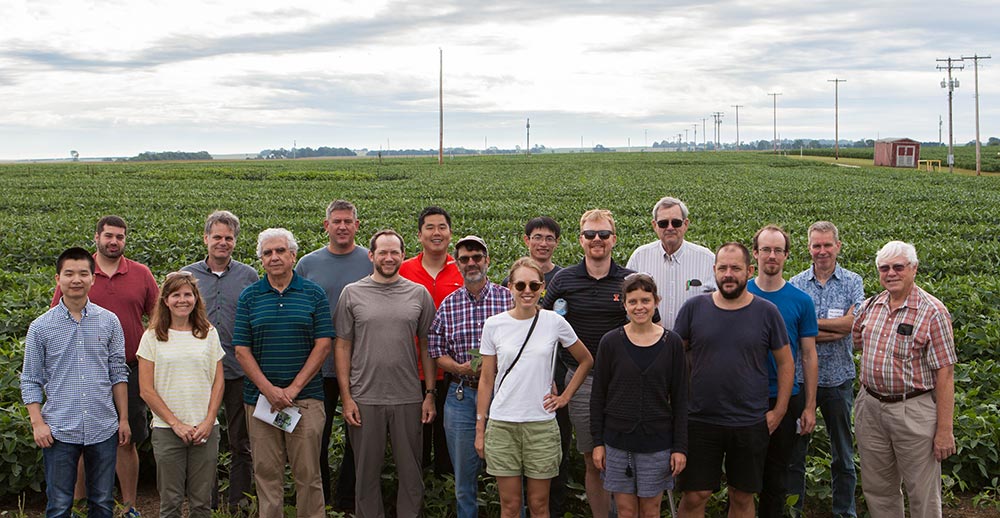Workshop “bridges” empirical, theoretical understandings of climate and crop yield
The societal stakes for assessing climate change impacts on agriculture and food supply are incredibly high. To meet this need, sophisticated computer models have been developed that simulate how crops grow and are influenced by their environment. They are like a three-dimensional jigsaw puzzle, with a multitude of interacting factors that must be correctly assembled.
In recognition of the magnitude of the problem and the cooperation that is required to solve it, researchers from the University of Illinois, the University of Birmingham, and other institutions around the world gathered at the Carl R. Woese Institute for Genomic Biology this month for a set of intense discussions on how to improve the capacity to predict the impact of climate on future crop yield. The workshop was supported by a seed grant from the Birmingham-Illinois Partnership for Discovery, Engagement and Education (BRIDGE).

“Our objective is to improve the ability of computer models to simulate the way crops are going to respond to rising carbon dioxide concentrations. That's an important exercise because the models are used to make projections about how future climate will impact food and fuel availability,” said co-organizer and Associate Professor of Plant Biology Andrew Leakey. “People have been running these models since the 1970s, but there's a real push at the moment to see if we can make them better at their job than they are currently.”
Leakey and his colleagues identified a specific strategy for the improvement of crop models: bring together the model developers, those who work to assemble the puzzle pieces of the changing climate’s impact, with experimentalists, those whose work to understand the biological mechanisms of response – which might be imagined as shaping the puzzle pieces.
“There are quite significant differences in culture and language between the modelers and the experimentalists, and so it's been really fantastic to identify a group of people who are all open to the possibility that they've got something to learn,” Leakey said.
Modeling experts who attended the workshop are particularly focused on representing and ultimately predicting the impact of rising carbon dioxide levels on crop yield. Superficially, it might appear that more carbon dioxide, the gas that is incorporated by photosynthesis into the sugars produced by plants, might help crops grow faster or yield more. However, interactions between plants and their environment are incredibly complex, a synthesis of factors including atmospheric and soil composition, plant respiration, water availability, and weather.
“[Some of] the equations in the models we use were not developed from recent experiments . . . I thought, we need to improve this,” said Delphine Deryng, another workshop co-organizer and scientific advisor for Climate Analytics. “What I wanted to do was engage with people working on the experimental side, to have some interaction on what could be done . . . and since I was working at the global scale, I was interested in knowing more about these experiments and why they are so complicated to develop in other places.”
It is a significant experimental challenge to gather real data on how crop plants respond to variations in carbon dioxide levels and other aspects of climate. The University of Illinois and the University of Birmingham are among just a handful of institutions with established experimental systems that have the capacity to perform such Free-Air Carbon Dioxide Enrichment (FACE) experiments. The SoyFACE project at Illinois is the second-oldest of such research efforts, examining effects on soybean yield; the BiFOR-FACE project at Birmingham assesses responses to changing carbon dioxide levels of a mature forest ecosystem.
Leakey, Deryng and a third co-organizer, Tom Pugh, recognized the mutual need for better communication between modelers and experimentalists. For example, experimentalists needed to know what data were lacking in present models in order to better target their efforts; modelers needed to know what types of experiments were possible, and what new information has already been gathered that could improve their models.
“We want to actually try and improve our models . . . some of these changes might be straightforward, but actually most of these changes we're discussing need more measurements, or quite substantial model development, or a lot of time invested to really understand model response and compare them to observations,” said Pugh, an environmental scientist and modeling expert from the University of Birmingham. “The workshop’s structure has really helped get people talking . . . this workshop is telling us everything we need to go back and figure out how to get from the models.”
As a result, the meeting has launched a series of collaborative relationships, which are expected to expand in the coming years, leading to significant scientific and practical advances in our ability to understand crop responses to climate change, and identify opportunities for adaptation.
